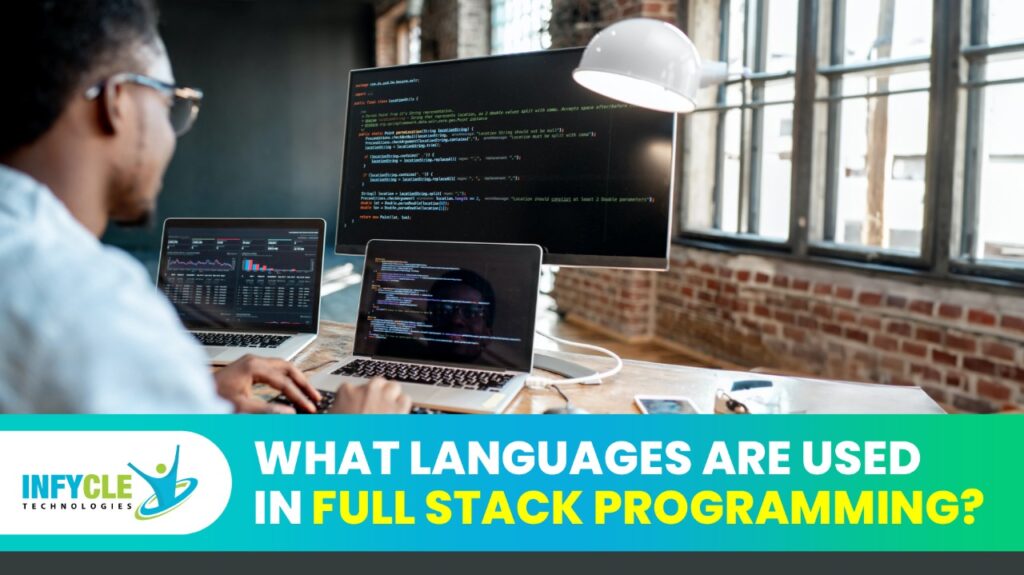What Languages Are Used In Full Stack Programming?
Are you planning to attend an interview for a full-stack developer position? Undoubtedly, having an understanding of both front-end and back-end development will advance your career and income. There are a few skill sets that you need to master before you start working as a full-stack developer. Acquiring knowledge of several programming languages is one of them.
With so many full-stack languages available, it can be difficult to know where to begin or quickly get confused. Every programming language has unique benefits and uses, which contribute to its popularity. Learning several programming languages is essential to becoming a full-stack developer so you can work on both the client-side and server-side tasks.
To make learning easier, we have compiled a list of the top full-stack languages. As the demand for full-stack developers grows, their salaries also rise. By mastering these fundamental languages, you’ll be on the right track towards developing into a skilled full-stack developer!
Who Is A Full Stack Developer?
As a full stack developer, you work both on the front end (client side) and back end (server side) of your web application. They have extensive experience creating complete websites as well as web applications. They also work with databases and troubleshoot web apps and web pages.
Multiple programming languages are necessary for full-stack web developers. Learning different programming languages is essential since no programming language is universally applicable. You can enroll in the Best Software Training Institute In Chennai to learn these programming languages. This blog will help you understand what languages are used in full-stack programming.
Now let’s get started.
Full Stack Developer Languages
If you’re an aspiring programmer or an experienced developer looking to level up, we’ve got you covered. The following are ten excellent programming languages that are a must-have for anyone who wants to do full-stack web development.
So, let’s discuss the top programming languages for developing full-stack applications.
JavaScript
JavaScript is an adaptive scripting language that enhances websites and applications with interactive features. Developers mostly use JavaScript to control how websites behave and interact with their users. However, JavaScript has many other fascinating applications.
A framework called Node.js allows JavaScript to be used in server-side applications. And frameworks like D3.js make JavaScript helpful for data visualization. There are also a variety of strong JavaScript frameworks available, such as Angular, React, jQuery, Vue, ExpressJS, and Backbone.
Due to its ability to run directly in web browsers, a wide ecosystem of frameworks, versatility in front-end and back-end development, and widespread adoption with high job demands, JavaScript is the best language for full-stack web development. You can join in Java Training in Chennai to learn Java programming more effectively.
Python
Full-stack developers frequently utilize Python, a free and open-source programming language. Its user-friendly and simple techniques help in the development of innovative applications. Python has quickly become extremely popular due to its highly connected network, which helps programmers write codes and solve problems more quickly.
Python’s readability, ease of use, and large library make it the second-best language for full-stack web development. It performs exceptionally well in machine learning, data processing, and back-end development. It is a common choice among developers due to its clear syntax, simplicity of usage, and widespread popularity. Thus, Python Is The Most Preferred Language by the full stack developers.
Ruby
Ruby is another popular full-stack programming language. This language has several properties that make it a wonderful language to build web applications since it is descriptive and flexible. For several reasons, Ruby is ranked as the third-best language for full-stack web development. Its wonderful syntax, readability, and versatility make it a delight. With Ruby on Rails, web development tasks are simplified, and the code is organized efficiently. Additionally, Ruby’s strong focus on developer satisfaction and its thriving community contribute to its popularity and viability for full-stack development.
Java
Java is an object-oriented, high-level programming language that is used for developing whole applications. Since the language is independent of the platform, it can operate on any hardware that supports its environment. Because of its performance and adaptability, Java remains developers’ most widely used programming language. Java allows you to do almost anything (practically anything.)
Platform independence, strong performance, and robustness make Java a top choice for full-stack web development. Using Java’s robust and scalable ecosystem of tools and frameworks, such as Spring, makes creating enterprise-level web applications easier. Its strict typing and comprehensive tooling support significantly improve its dependability and ease of maintenance.
PHP
PHP is a popular, multipurpose, open-source programming language that works particularly well for web development. Being one of the first server-side languages that programmers integrated into HTML, PHP gained popularity. A robust open-source community supports PHP, and it is also quick, safe, and adaptable. As a specialized language, PHP has an advantage over other general-purpose languages like Python, even though it is less popular than other languages.
Because of its broad use, robust community, and simple database integration, PHP is ranked as the fifth-best programming language for full-stack web development. It is perfect for creating interactive and adaptable web applications because it comes with a wide range of functionality, solid frameworks like Laravel, and a smooth interface with well-known CMS platforms.
C#
Microsoft developed the C# programming language as part of its DOT NET initiative around 2000. It is a programming language that is versatile, object-oriented, and component-oriented. C# is part of the C family of languages, sharing similarities with C, C++, Java, and JavaScript. Because of its comprehensive tooling support, object-oriented programming skills, and statically typed architecture, it is a good choice for creating scalable and reliable web applications that run on the Microsoft platform.
Go
Google developed the object-oriented programming language Go in 2009 for networking and infrastructure. However, since its release, it has developed into a general-purpose language that may be used for various tasks. Go is the fastest-growing programming language, making it a smart choice for full-stack development. Its efficient memory management, robust standard library, and compiled nature make it the best option for creating web applications that need to be scalable, highly concurrent, and low latency.
C++
C++ is a universal, compiled, and static-typed programming language. Its, sometimes known as “C with Classes,” is a modified version of C that adds the features of user-defined data classes. Because of its great efficiency, C++ is the best language for applications requiring quick rendering, such as banking apps, motion graphics tools, and browsers.
Another important factor in C++’s popularity is its ability to interact directly with system hardware. For hardware-oriented applications such as video game engines, operating systems, and cloud systems, developers frequently select C++ as their primary choice. C++ is great for full-stack developers who value performance and code reuse.
Rust
Rust is a contemporary and high-performance full-stack programming language with essential features that prioritize security, concurrency, and efficiency. Its maintains memory safety without losing speed with the help of its robust type system and borrowing rules. Its contemporary features and expanding ecosystem make it ideal for developing safe and effective web applications.
Swift
Swift, a relatively new but still extensively used programming language invented and released by Apple Inc., was created to exclusively code their products and technology. The language has a large number of libraries and tools that make development simple, rapid, and secure. Swift is well-known for emphasizing security measures.
Swift, which was created for iOS as well as macOS app development, is now a viable choice for constructing back-end systems and interfacing with front-end technologies, thus boosting its importance in full-stack development.
To know more about full-stack development and how to become one, read our blog about A Detailed Roadmap To Be A Full Stack Developer In 2023!
Conclusion
You are probably now familiar with the top ten programming languages used in full-stack development. It can be challenging to select the best language for full-stack development. As you continue to explore coding, these languages will be your reliable companions. But keep in mind that this is only the beginning. There are a lot of languages to learn in the broad and dynamic world of coding.
Thus, maintain your curiosity and keep learning and developing. It’s now your chance to make your mark in the fascinating field of full-stack web development. So go ahead, learn the most advanced programming language for creating full-stack websites, become an adventurous coder, and make others happy with your efforts.





